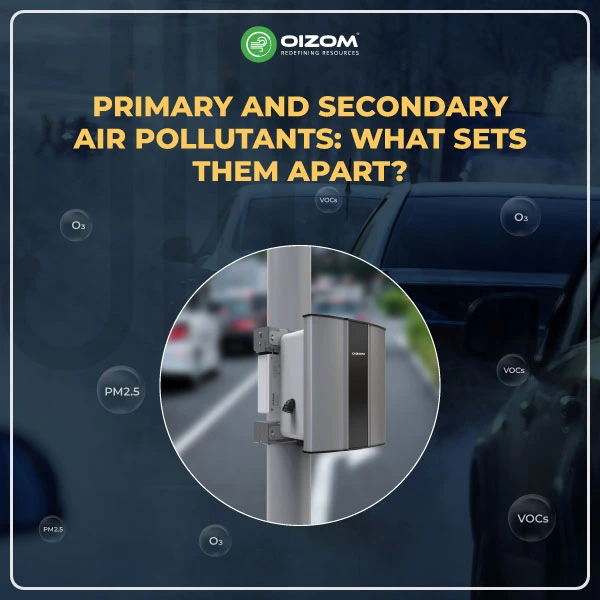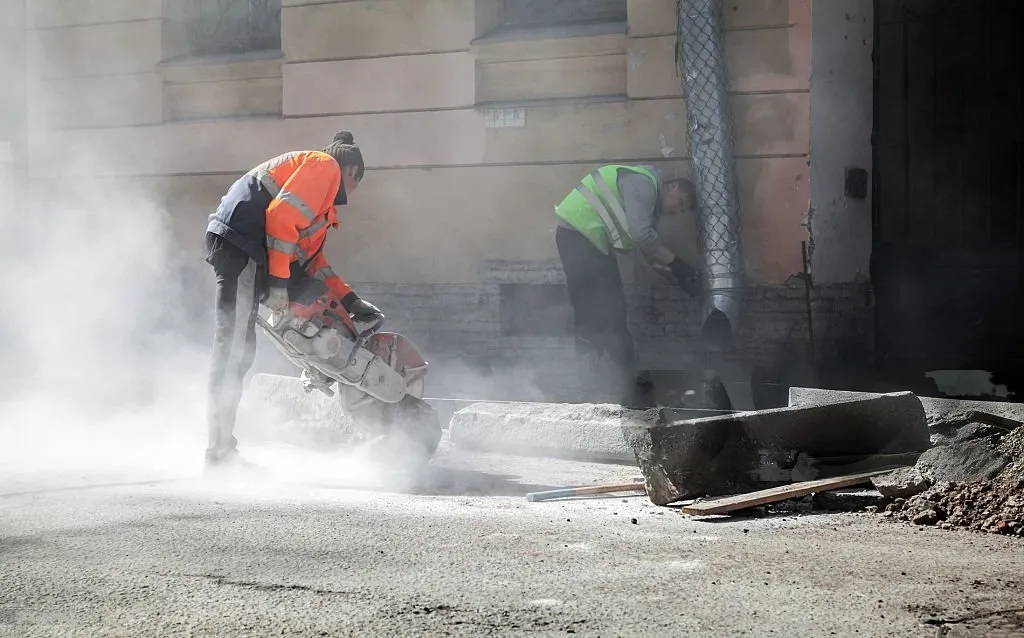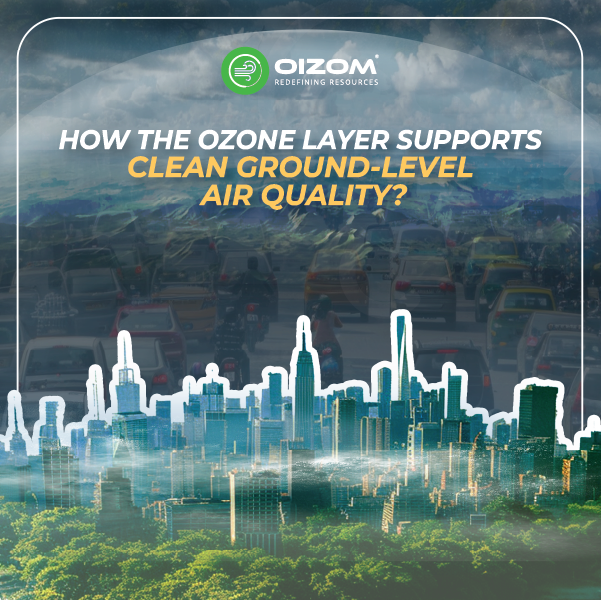Summary
Did you know that around 80% of PM2.5 in Indian cities comes from secondary pollutant formation and not directly from cars or factories? Which directly means that the air we breathe is shaped by invisible chemical reactions rather than the visible smoke.
In this blog, we will break down the two major types of air pollutants: primary pollutants, released directly from sources like vehicles, industries, and construction, and secondary pollutants, which form in the atmosphere when primary emissions react with sunlight, moisture, or other elements.
We will also figure out how they affect our health and environment, and why secondary pollutants are often harder to detect and control. Based on this knowledge we’ll also uncover how dangerous primary and secondary pollutants can be with global-level high-impact occurrences like the London Smog and the Taj Mahal’s acid rain damage
Introduction
Whenever the topic of air pollution is highlighted, what’s often overlooked is that not all pollutants are created equal. Right from the visible smog to the invisible irritants we breathe, understanding the key difference between primary and secondary air pollutants helps us simplify what’s really in the air and how it will impact us.
The World Health Organization has estimated air pollution to be responsible for millions of premature deaths globally each year, many of them linked to fine particulate matter and harmful gases, both primary and secondary in nature. In India, regulatory bodies such as CPCB have also recognized pollutants like PM2.5, NOx, and ground-level ozone as key contributors to rising public health risks.
This leads us to a fundamental question: What are primary and secondary air pollutants in the first place? That’s what this article explores. Whether you’re a concerned citizen, a student, an industrialist, or simply someone curious about our environmental reality, this guide will help you understand the basics and, more importantly, the impact of the air pollutants around us.
Key Differences Between Primary & Secondary Air Pollutants:
Air pollutants can be deceptively complex while some are straightforward, others are a result of intricate chemical reactions. Let’s break down what makes primary and secondary pollutants different, and why understanding them matters to all of us.
Primary Air Pollutants are emitted directly into the atmosphere in harmful form. Common sources: Vehicles, factories, power plants, wildfires, and agriculture. Examples: Carbon monoxide (CO), Nitrogen oxides (NOₓ), Sulfur dioxide (SO₂), Particulate matter (PM₁₀, PM₂.₅), Volatile organic compounds (VOCs), Ammonia (NH₃)
Secondary Air Pollutants are formed in the atmosphere through chemical reactions of primary pollutants. They are triggered by elements like sunlight, water vapor, or oxygen, and are harder to trace due to complex formation processes. Examples include: Ground-level ozone (O₃) Acid rain (from SO₂ and NOₓ) Secondary PM₂.₅ Peroxyacetyl nitrate (PAN)
Key Differences:
- Primary air pollutants ~ Pollutants emitted directly
- Secondary air pollutants ~ Pollutants formed through reactions of primary pollutants.
- Primary sources are identifiable, whereas secondary pollutants are atmospheric by-products.
A study shows that up to 80% of PM2.5 in cities like Delhi is formed secondarily from gaseous pollutants like NOx, SO₂, and VOCs reacting in the atmosphere. (Source: UrbanEmissions.info, CPCB study)
What Are Primary Air Pollutants?
Primary air pollutants are substances that are directly released into the atmosphere from a specific source in their harmful form. They do not undergo any chemical transformation in the air before causing impact. These pollutants can originate from both human activities and natural events. As they enter the air unchanged, they are often the first targets of air quality regulations and pollution control strategies.
Common Sources Of Primary Air Pollutants:
Primary air pollutants originate from a wide range of sources, which can be broadly categorized into human-induced and natural sources:
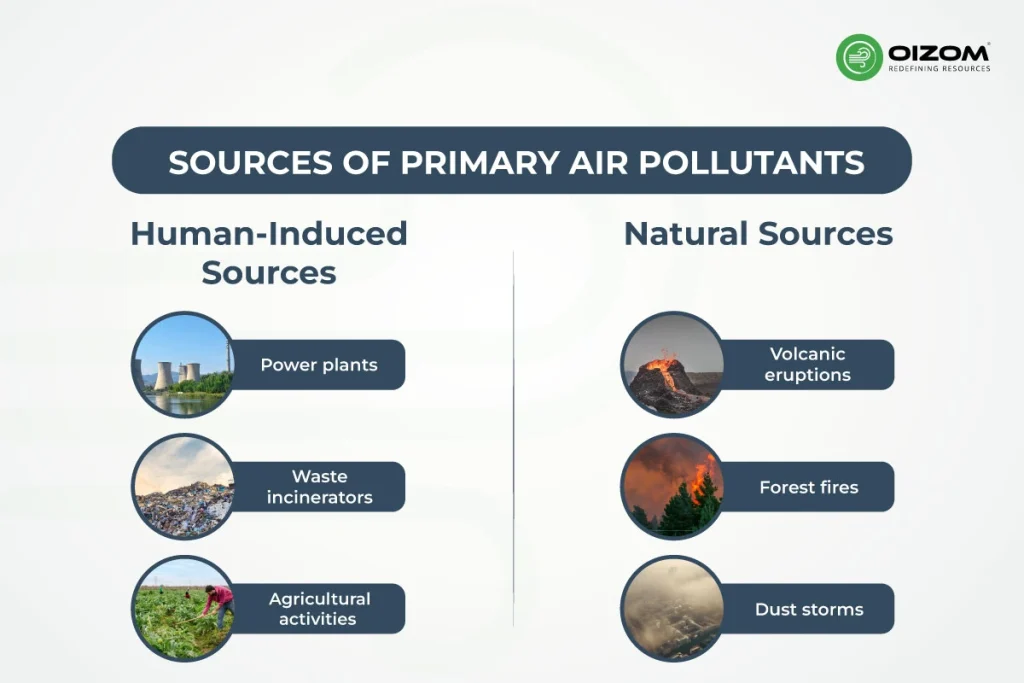
Human-Induced Sources:
These are caused by everyday human activities such as fuel burning, industrial production, and transportation.
1.Point sources:
Emissions from a single, identifiable source such as:
– Power plants
– Industrial facilities
– Waste incinerators check the formatting
Thermal power plants contribute ~51% of SO₂ emissions in India.[Source: CSE India – Emission Inventory Report]
2.Mobile sources:
Moving sources that emit pollutants during operation:
– Vehicular emissions, off-road vehicles
– Trains, ships, and airplanes
3.Area/non-point sources (Diffused emissions over a large area):
– Residential wood or biomass burning
– Agricultural activities
– Small industries or construction sites
Industrial combustion accounts for ~30–35% of NOx and PM emissions in urban industrial areas. In particular, biomass and waste-to-energy plants play a notable role in primary pollutant emissions, making it important to understand their impact on local and regional air quality.
Natural Sources:
While human activities are a major contributor, nature also plays a role in releasing pollutants into the air.
- Volcanic eruptions (SO2, PM10)
- Forest fires and wildfires (CO, PM2.5, PM10)
- Dust storms (PM10)
- Sea spray and biological decay (VOCs, particulates)
Examples Of Primary Air Pollutants:
1.PM2.5 (Particulate Matter 2.5)
These ultra-fine particles can lodge deep in the lungs and even enter the bloodstream, causing heart and respiratory diseases. They are mainly emitted from vehicle exhaust, industrial processes, construction activities, and wildfires.
2.Carbon Monoxide (CO):
A colorless, odorless gas that reduces the oxygen-carrying capacity of blood, posing serious health risks. It is mostly released by motor vehicles, residential heating systems, generators, and other sources of incomplete fuel combustion.
3.Nitrogen Oxides (NOₓ):
This group of reactive gases, including NO and NO₂, contributes to lung irritation, smog, and ground-level ozone. The primary sources are combustion engines (especially diesel vehicles), power plants, and industrial boilers.
4.Sulfur Dioxide (SO₂):
A pungent gas that can trigger respiratory issues and contributes to acid rain and particulate formation. It is mainly produced by burning sulfur-containing fossil fuels in coal-fired power plants, oil refineries, and metal smelting.
5.Volatile Organic Compounds (VOCs):
These easily evaporating chemicals can be harmful on their own and also lead to the formation of secondary pollutants like ozone. Major sources include paints, solvents, fuel vapors, industrial processes, and vehicle emissions.
6.Ammonia (NH₃):
A sharp-smelling gas that combines with other pollutants in the air to form harmful fine particles. It is primarily released from agricultural activities, including fertilizer application and livestock waste.
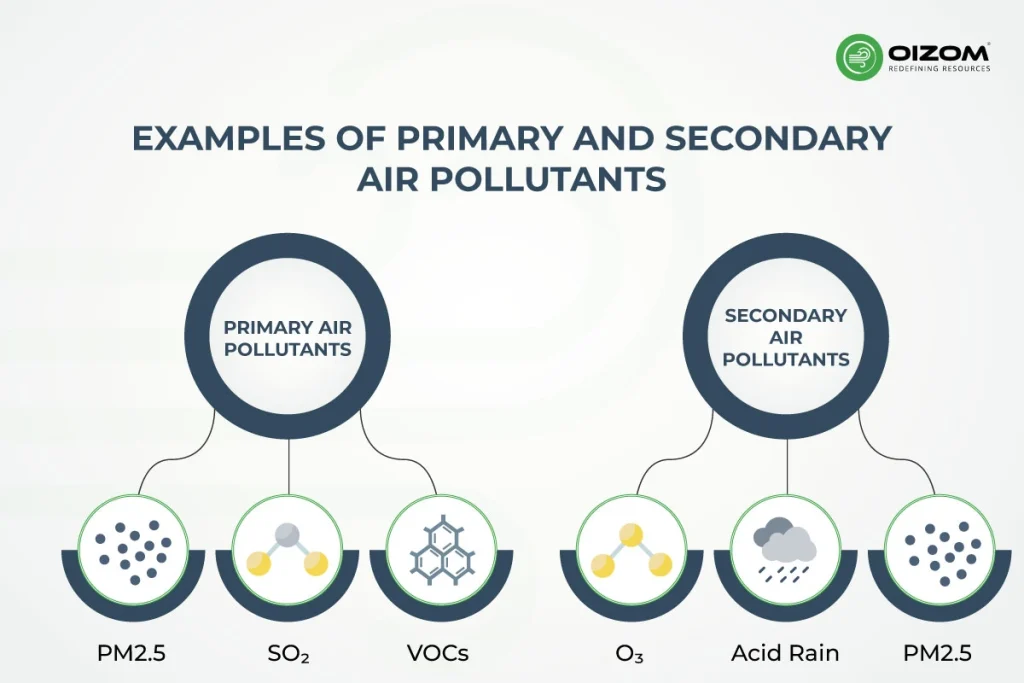
What Are Secondary Air Pollutants?
Secondary pollutants are not emitted directly but are formed in the atmosphere when primary pollutants undergo chemical reactions with each other. These reactions can also be triggered by natural elements like sunlight, water vapor, or oxygen. These reactions result in new compounds which are often more harmful or persistent than the parent pollutants. Since their formation depends on environmental conditions, secondary pollutants can be more difficult to trace and manage through direct emission controls.
Examples Of Secondary Air Pollutants:
1.Ground-Level Ozone (O₃)
Formed when nitrogen oxides and VOCs react in the presence of sunlight, creating a harmful component of smog.
NOₓ + VOCs + sunlight → O₃
2.Acid Rain (H₂SO₄, HNO₃)
Occurs when sulfur dioxide and nitrogen oxides react with water vapor in the atmosphere to form acidic compounds.
SO₂ + H₂O → H₂SO₄
NOₓ + H₂O → HNO₃
3.Secondary Particulate Matter (PM2.5)
Generated when gases like SO₂, NOₓ, and NH₃ react in the air to form fine particles such as sulfates, nitrates, and ammonium salts.
SO₂/NOₓ + NH₃ + H₂O → (NH₄)₂SO₄ / NH₄NO₃ (PM₂.5).
This was notably captured in Oizom’s Gelephu case study, where our instruments notably Polludrone recorded spikes in secondary PM2.5 due to SO₂ and NH₃ interactions.
4.Peroxyacetyl Nitrate (PAN)
A highly reactive and irritating compound formed in photochemical smog. PAN can travel long distances and affects both human health and plant life, especially in warm, sunny climates.
Formation Of Secondary Air Pollutants:
Ground-Level Ozone (O₃): NOₓ + VOCs + sunlight → O₃
Acid Rain (H₂SO₄, HNO₃): SO₂ + H₂O → H₂SO₄
NOₓ + H₂O → HNO₃
Particulate Matter (PM2.5): SO₂/NOₓ + NH₃ + H₂O → (NH₄)₂SO₄ / NH₄NO₃ (PM₂.5)
Peroxyacetyl Nitrate (PAN): VOCs + NOₓ + sunlight → PAN (Peroxyacetyl Nitrate)
What Are The Most Dangerous Primary Air Pollutants & Secondary Air Pollutants?
Among all primary air pollutants, particulate matter (especially PM₂.₅), carbon monoxide (CO), sulfur dioxide (SO₂), and nitrogen oxides (NOₓ) are considered the most harmful to human health and the environment. Their direct release into the air means they can cause immediate respiratory, cardiovascular, and neurological effects.
Example: The Great London Smog of 1952 is a powerful example, where a lethal mix of SO₂ and particulate matter led to thousands of premature deaths within days.
Ground-level ozone (O₃), acid rain (H₂SO₄ and HNO₃), and secondary particulate matter are among the most dangerous secondary pollutants. These compounds form in the atmosphere through chemical reactions involving primary pollutants, often becoming more toxic or persistent.
Example: A notable example of damage caused by secondary pollutants is the damage to the Taj Mahal, where acid rain has gradually discolored and eroded the iconic marble.
Conclusion
Over the years air pollution has emerged as a global challenge affecting the way we live and our collective future. Understanding primary and secondary air pollutants isn’t just for academic purposes but it can also help us in tracing pollution to its sources and to form smarter solutions. Whether it’s direct emissions from traffic or harmful compounds forming in the sky, both types impact our health, climate, and future. Tackling them requires not just action, but informed action.
Monitoring and managing both primary and secondary pollutants require accurate, real-time data. Tools like Oizom’s Polludrone and the Envizom platform offer a complete solution by tracking everything from direct emissions to atmospheric transformations, which helps in making sound and smarter decisions for cleaner air. Clean air is a basic need. And with the right technology, collaboration, and awareness, we can move closer to a world where everyone can breathe a little easier.

